Kingston and St George’s University London
VerifiedAdded on 2022/08/25
|9
|2085
|16
AI Summary
Contribute Materials
Your contribution can guide someone’s learning journey. Share your
documents today.
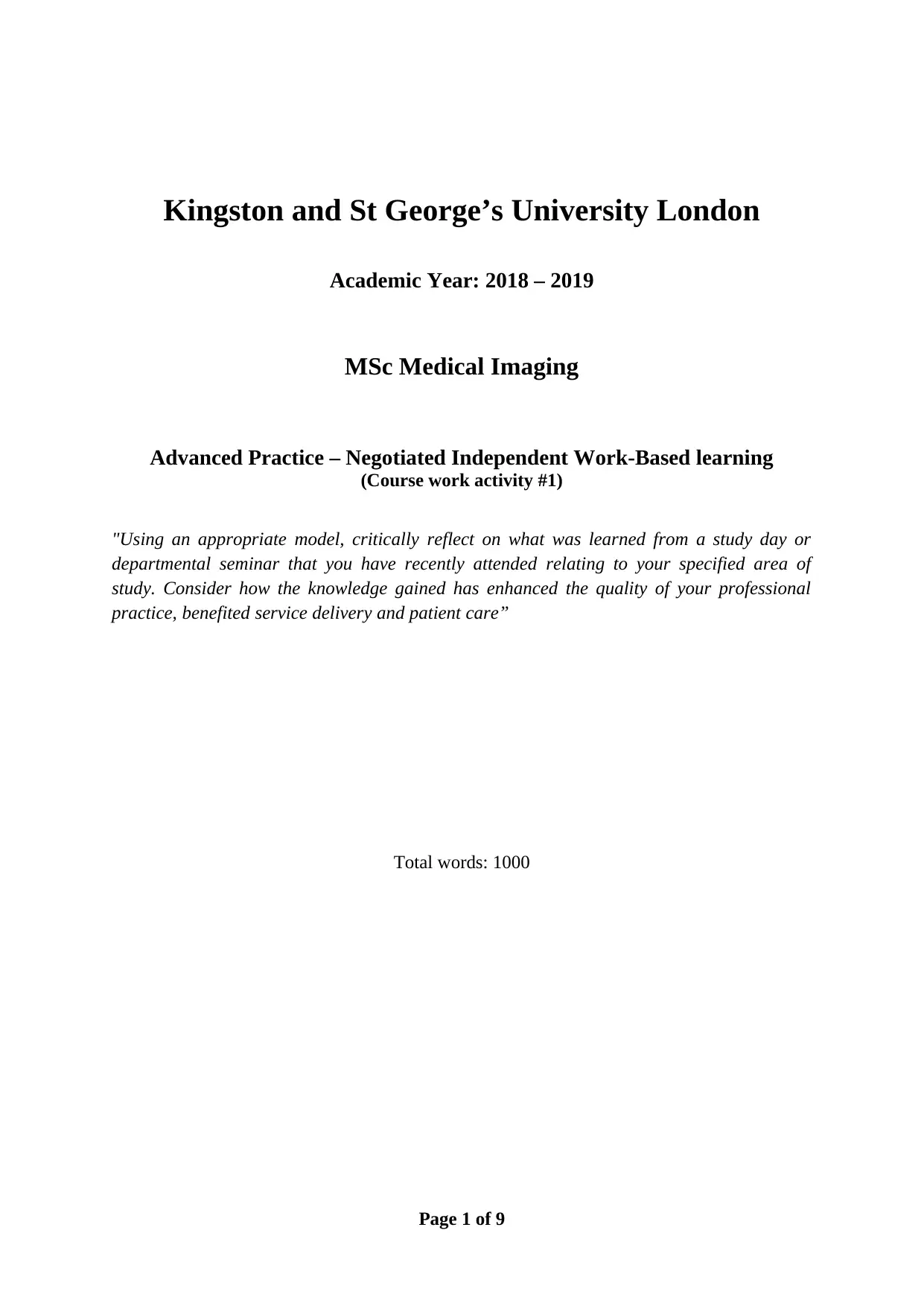
Kingston and St George’s University London
Academic Year: 2018 – 2019
MSc Medical Imaging
Advanced Practice – Negotiated Independent Work-Based learning
(Course work activity #1)
"Using an appropriate model, critically reflect on what was learned from a study day or
departmental seminar that you have recently attended relating to your specified area of
study. Consider how the knowledge gained has enhanced the quality of your professional
practice, benefited service delivery and patient care”
Total words: 1000
Page 1 of 9
Academic Year: 2018 – 2019
MSc Medical Imaging
Advanced Practice – Negotiated Independent Work-Based learning
(Course work activity #1)
"Using an appropriate model, critically reflect on what was learned from a study day or
departmental seminar that you have recently attended relating to your specified area of
study. Consider how the knowledge gained has enhanced the quality of your professional
practice, benefited service delivery and patient care”
Total words: 1000
Page 1 of 9
Secure Best Marks with AI Grader
Need help grading? Try our AI Grader for instant feedback on your assignments.
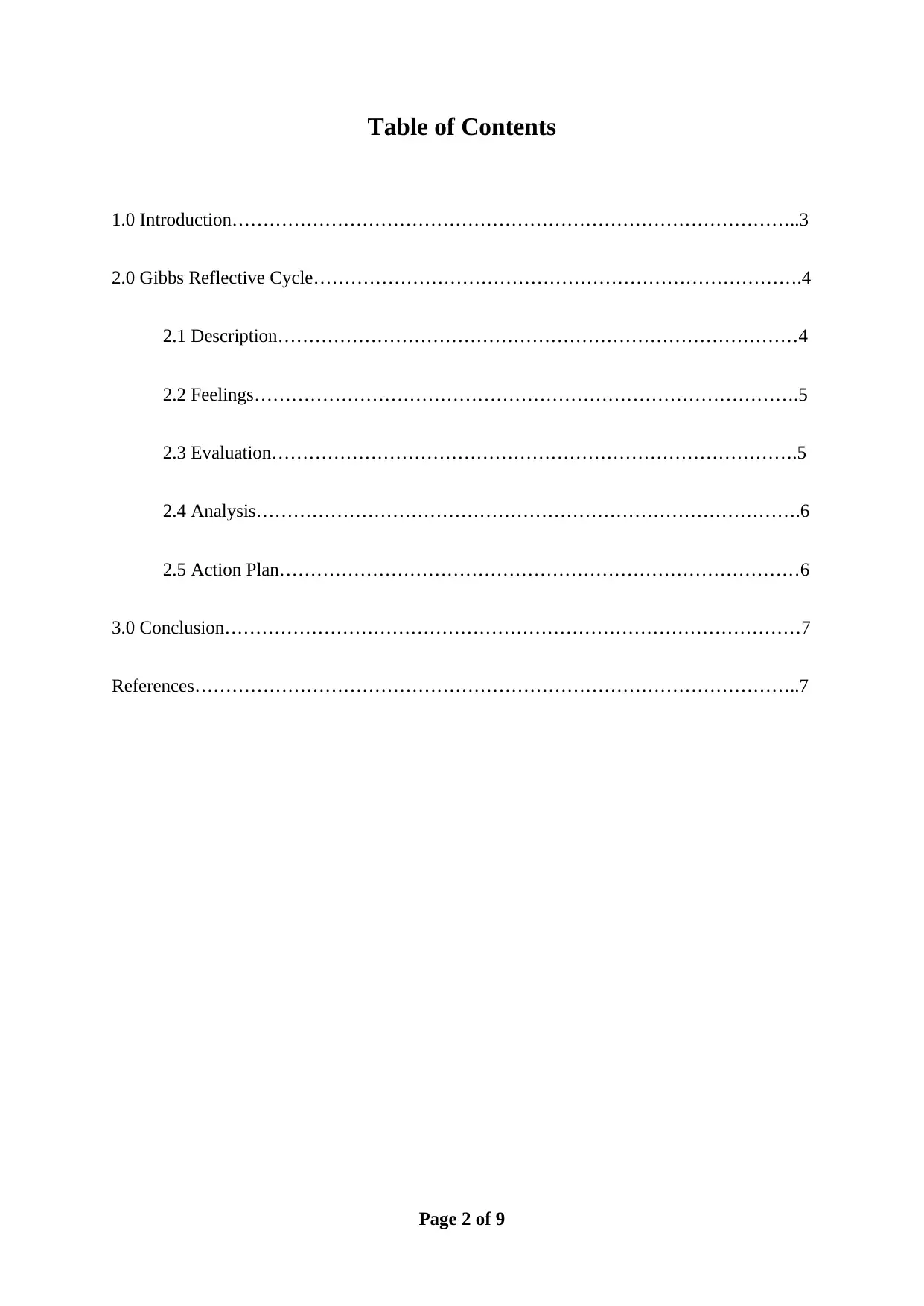
Table of Contents
1.0 Introduction………………………………………………………………………………..3
2.0 Gibbs Reflective Cycle…………………………………………………………………….4
2.1 Description…………………………………………………………………………4
2.2 Feelings…………………………………………………………………………….5
2.3 Evaluation………………………………………………………………………….5
2.4 Analysis…………………………………………………………………………….6
2.5 Action Plan…………………………………………………………………………6
3.0 Conclusion…………………………………………………………………………………7
References……………………………………………………………………………………..7
Page 2 of 9
1.0 Introduction………………………………………………………………………………..3
2.0 Gibbs Reflective Cycle…………………………………………………………………….4
2.1 Description…………………………………………………………………………4
2.2 Feelings…………………………………………………………………………….5
2.3 Evaluation………………………………………………………………………….5
2.4 Analysis…………………………………………………………………………….6
2.5 Action Plan…………………………………………………………………………6
3.0 Conclusion…………………………………………………………………………………7
References……………………………………………………………………………………..7
Page 2 of 9
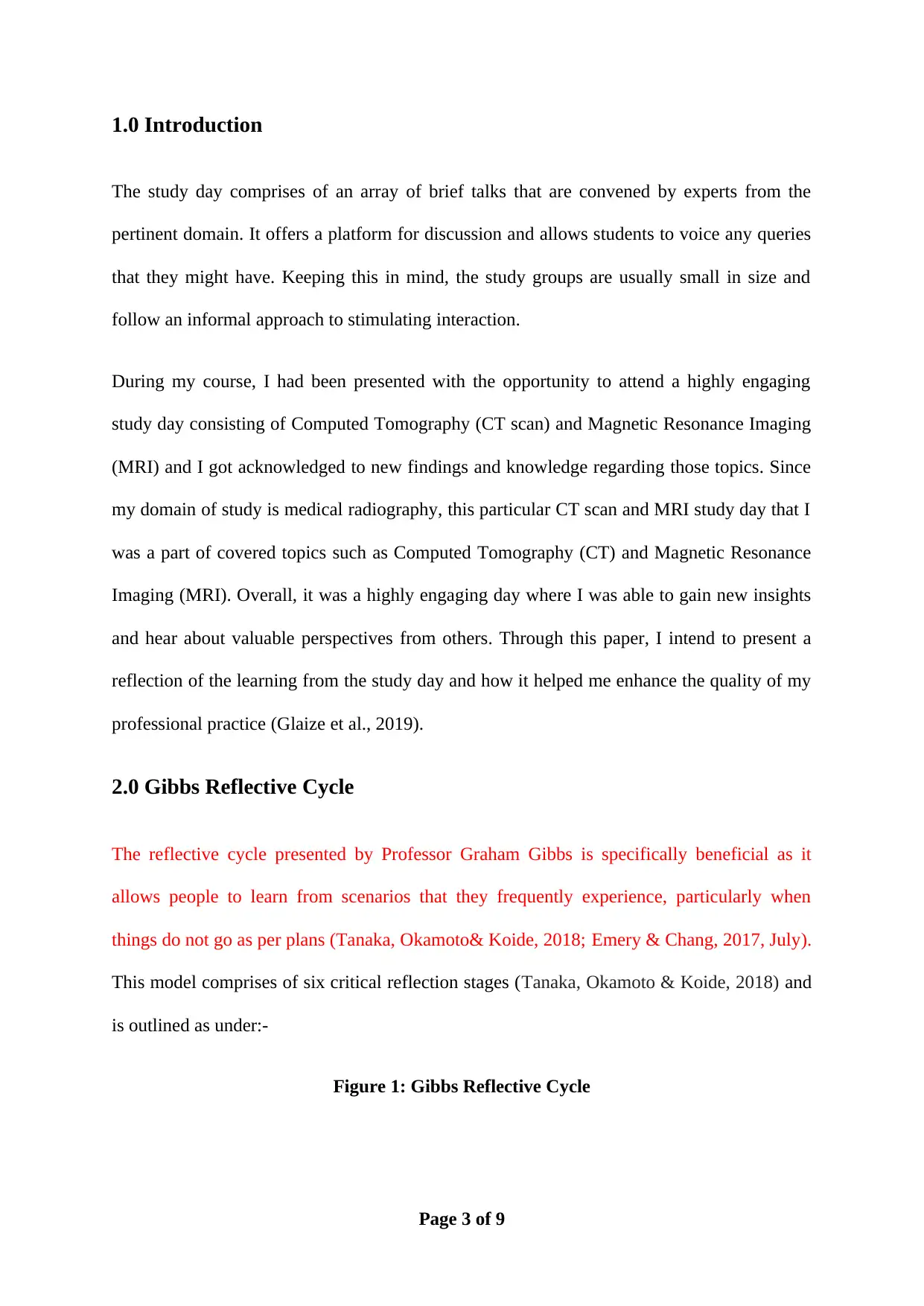
1.0 Introduction
The study day comprises of an array of brief talks that are convened by experts from the
pertinent domain. It offers a platform for discussion and allows students to voice any queries
that they might have. Keeping this in mind, the study groups are usually small in size and
follow an informal approach to stimulating interaction.
During my course, I had been presented with the opportunity to attend a highly engaging
study day consisting of Computed Tomography (CT scan) and Magnetic Resonance Imaging
(MRI) and I got acknowledged to new findings and knowledge regarding those topics. Since
my domain of study is medical radiography, this particular CT scan and MRI study day that I
was a part of covered topics such as Computed Tomography (CT) and Magnetic Resonance
Imaging (MRI). Overall, it was a highly engaging day where I was able to gain new insights
and hear about valuable perspectives from others. Through this paper, I intend to present a
reflection of the learning from the study day and how it helped me enhance the quality of my
professional practice (Glaize et al., 2019).
2.0 Gibbs Reflective Cycle
The reflective cycle presented by Professor Graham Gibbs is specifically beneficial as it
allows people to learn from scenarios that they frequently experience, particularly when
things do not go as per plans (Tanaka, Okamoto& Koide, 2018; Emery & Chang, 2017, July).
This model comprises of six critical reflection stages (Tanaka, Okamoto & Koide, 2018) and
is outlined as under:-
Figure 1: Gibbs Reflective Cycle
Page 3 of 9
The study day comprises of an array of brief talks that are convened by experts from the
pertinent domain. It offers a platform for discussion and allows students to voice any queries
that they might have. Keeping this in mind, the study groups are usually small in size and
follow an informal approach to stimulating interaction.
During my course, I had been presented with the opportunity to attend a highly engaging
study day consisting of Computed Tomography (CT scan) and Magnetic Resonance Imaging
(MRI) and I got acknowledged to new findings and knowledge regarding those topics. Since
my domain of study is medical radiography, this particular CT scan and MRI study day that I
was a part of covered topics such as Computed Tomography (CT) and Magnetic Resonance
Imaging (MRI). Overall, it was a highly engaging day where I was able to gain new insights
and hear about valuable perspectives from others. Through this paper, I intend to present a
reflection of the learning from the study day and how it helped me enhance the quality of my
professional practice (Glaize et al., 2019).
2.0 Gibbs Reflective Cycle
The reflective cycle presented by Professor Graham Gibbs is specifically beneficial as it
allows people to learn from scenarios that they frequently experience, particularly when
things do not go as per plans (Tanaka, Okamoto& Koide, 2018; Emery & Chang, 2017, July).
This model comprises of six critical reflection stages (Tanaka, Okamoto & Koide, 2018) and
is outlined as under:-
Figure 1: Gibbs Reflective Cycle
Page 3 of 9
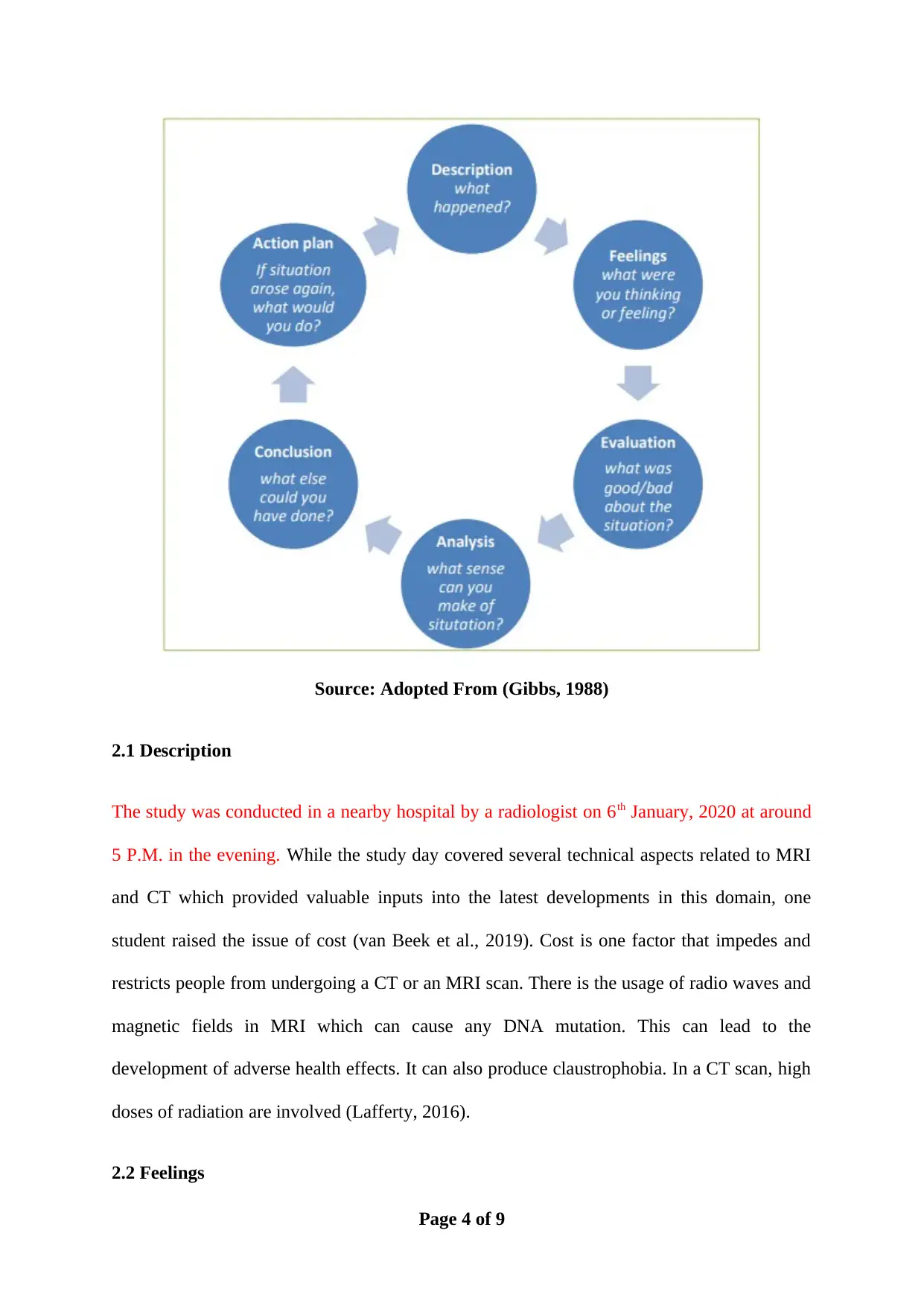
Source: Adopted From (Gibbs, 1988)
2.1 Description
The study was conducted in a nearby hospital by a radiologist on 6th January, 2020 at around
5 P.M. in the evening. While the study day covered several technical aspects related to MRI
and CT which provided valuable inputs into the latest developments in this domain, one
student raised the issue of cost (van Beek et al., 2019). Cost is one factor that impedes and
restricts people from undergoing a CT or an MRI scan. There is the usage of radio waves and
magnetic fields in MRI which can cause any DNA mutation. This can lead to the
development of adverse health effects. It can also produce claustrophobia. In a CT scan, high
doses of radiation are involved (Lafferty, 2016).
2.2 Feelings
Page 4 of 9
2.1 Description
The study was conducted in a nearby hospital by a radiologist on 6th January, 2020 at around
5 P.M. in the evening. While the study day covered several technical aspects related to MRI
and CT which provided valuable inputs into the latest developments in this domain, one
student raised the issue of cost (van Beek et al., 2019). Cost is one factor that impedes and
restricts people from undergoing a CT or an MRI scan. There is the usage of radio waves and
magnetic fields in MRI which can cause any DNA mutation. This can lead to the
development of adverse health effects. It can also produce claustrophobia. In a CT scan, high
doses of radiation are involved (Lafferty, 2016).
2.2 Feelings
Page 4 of 9
Secure Best Marks with AI Grader
Need help grading? Try our AI Grader for instant feedback on your assignments.
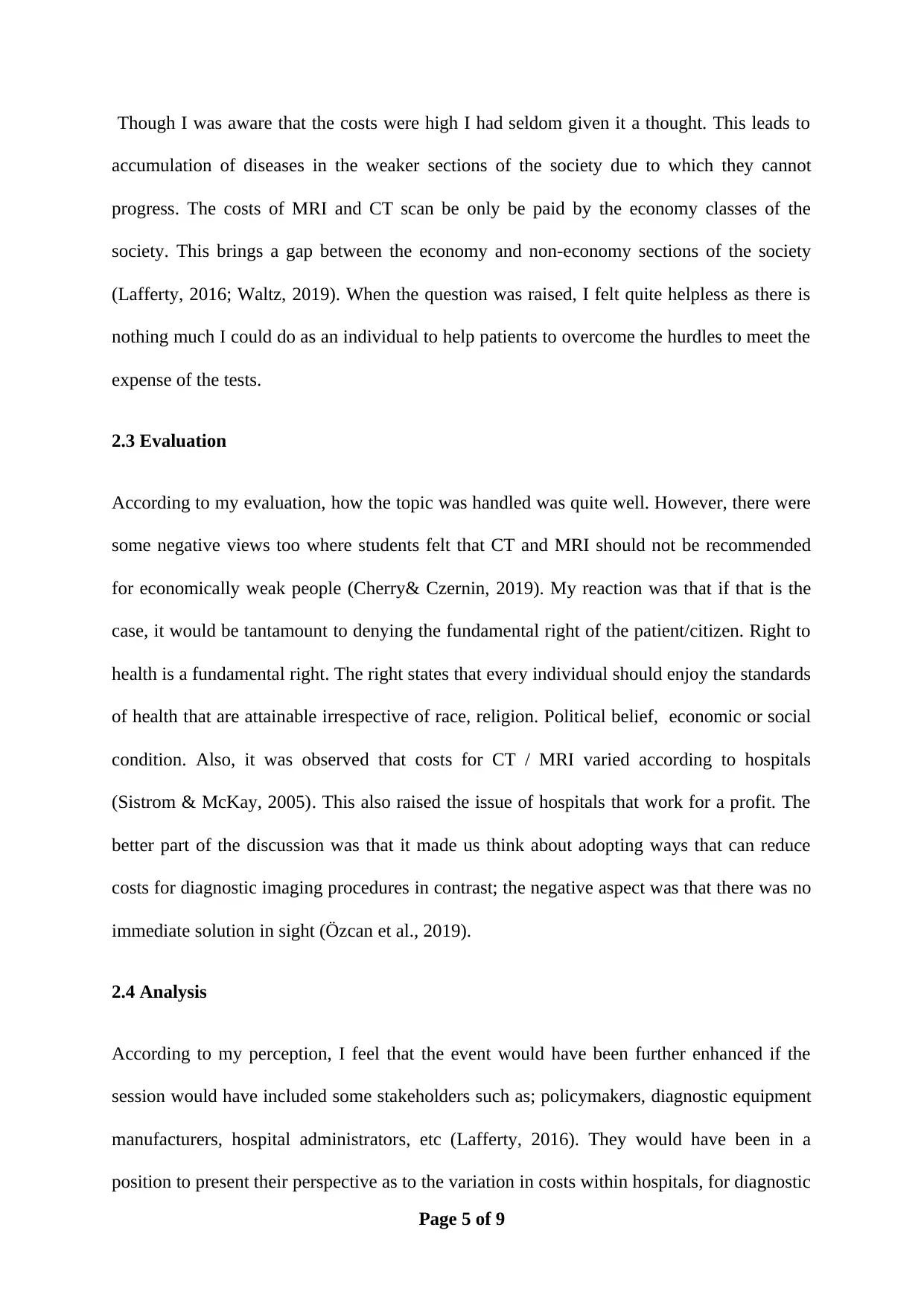
Though I was aware that the costs were high I had seldom given it a thought. This leads to
accumulation of diseases in the weaker sections of the society due to which they cannot
progress. The costs of MRI and CT scan be only be paid by the economy classes of the
society. This brings a gap between the economy and non-economy sections of the society
(Lafferty, 2016; Waltz, 2019). When the question was raised, I felt quite helpless as there is
nothing much I could do as an individual to help patients to overcome the hurdles to meet the
expense of the tests.
2.3 Evaluation
According to my evaluation, how the topic was handled was quite well. However, there were
some negative views too where students felt that CT and MRI should not be recommended
for economically weak people (Cherry& Czernin, 2019). My reaction was that if that is the
case, it would be tantamount to denying the fundamental right of the patient/citizen. Right to
health is a fundamental right. The right states that every individual should enjoy the standards
of health that are attainable irrespective of race, religion. Political belief, economic or social
condition. Also, it was observed that costs for CT / MRI varied according to hospitals
(Sistrom & McKay, 2005). This also raised the issue of hospitals that work for a profit. The
better part of the discussion was that it made us think about adopting ways that can reduce
costs for diagnostic imaging procedures in contrast; the negative aspect was that there was no
immediate solution in sight (Özcan et al., 2019).
2.4 Analysis
According to my perception, I feel that the event would have been further enhanced if the
session would have included some stakeholders such as; policymakers, diagnostic equipment
manufacturers, hospital administrators, etc (Lafferty, 2016). They would have been in a
position to present their perspective as to the variation in costs within hospitals, for diagnostic
Page 5 of 9
accumulation of diseases in the weaker sections of the society due to which they cannot
progress. The costs of MRI and CT scan be only be paid by the economy classes of the
society. This brings a gap between the economy and non-economy sections of the society
(Lafferty, 2016; Waltz, 2019). When the question was raised, I felt quite helpless as there is
nothing much I could do as an individual to help patients to overcome the hurdles to meet the
expense of the tests.
2.3 Evaluation
According to my evaluation, how the topic was handled was quite well. However, there were
some negative views too where students felt that CT and MRI should not be recommended
for economically weak people (Cherry& Czernin, 2019). My reaction was that if that is the
case, it would be tantamount to denying the fundamental right of the patient/citizen. Right to
health is a fundamental right. The right states that every individual should enjoy the standards
of health that are attainable irrespective of race, religion. Political belief, economic or social
condition. Also, it was observed that costs for CT / MRI varied according to hospitals
(Sistrom & McKay, 2005). This also raised the issue of hospitals that work for a profit. The
better part of the discussion was that it made us think about adopting ways that can reduce
costs for diagnostic imaging procedures in contrast; the negative aspect was that there was no
immediate solution in sight (Özcan et al., 2019).
2.4 Analysis
According to my perception, I feel that the event would have been further enhanced if the
session would have included some stakeholders such as; policymakers, diagnostic equipment
manufacturers, hospital administrators, etc (Lafferty, 2016). They would have been in a
position to present their perspective as to the variation in costs within hospitals, for diagnostic
Page 5 of 9
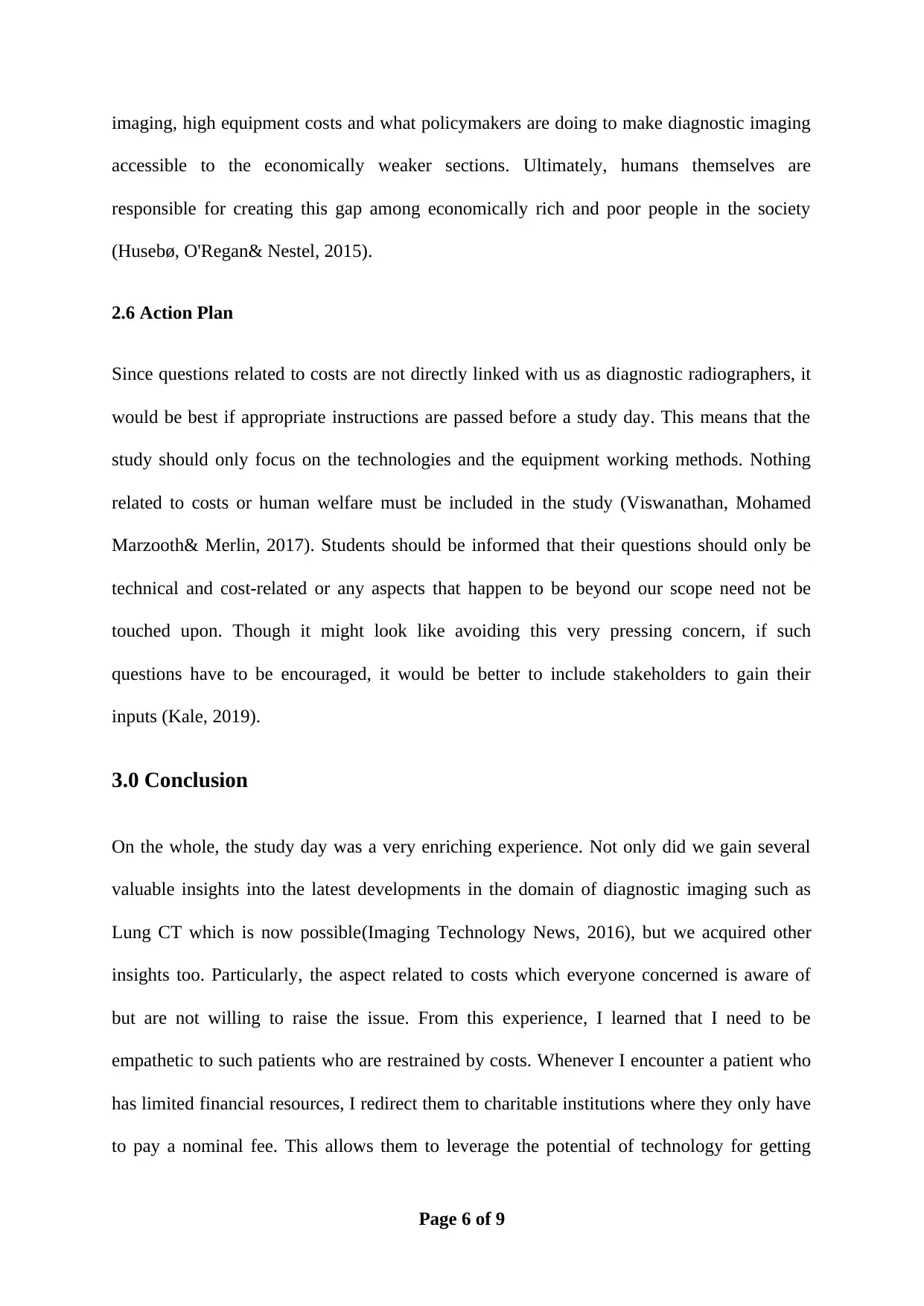
imaging, high equipment costs and what policymakers are doing to make diagnostic imaging
accessible to the economically weaker sections. Ultimately, humans themselves are
responsible for creating this gap among economically rich and poor people in the society
(Husebø, O'Regan& Nestel, 2015).
2.6 Action Plan
Since questions related to costs are not directly linked with us as diagnostic radiographers, it
would be best if appropriate instructions are passed before a study day. This means that the
study should only focus on the technologies and the equipment working methods. Nothing
related to costs or human welfare must be included in the study (Viswanathan, Mohamed
Marzooth& Merlin, 2017). Students should be informed that their questions should only be
technical and cost-related or any aspects that happen to be beyond our scope need not be
touched upon. Though it might look like avoiding this very pressing concern, if such
questions have to be encouraged, it would be better to include stakeholders to gain their
inputs (Kale, 2019).
3.0 Conclusion
On the whole, the study day was a very enriching experience. Not only did we gain several
valuable insights into the latest developments in the domain of diagnostic imaging such as
Lung CT which is now possible(Imaging Technology News, 2016), but we acquired other
insights too. Particularly, the aspect related to costs which everyone concerned is aware of
but are not willing to raise the issue. From this experience, I learned that I need to be
empathetic to such patients who are restrained by costs. Whenever I encounter a patient who
has limited financial resources, I redirect them to charitable institutions where they only have
to pay a nominal fee. This allows them to leverage the potential of technology for getting
Page 6 of 9
accessible to the economically weaker sections. Ultimately, humans themselves are
responsible for creating this gap among economically rich and poor people in the society
(Husebø, O'Regan& Nestel, 2015).
2.6 Action Plan
Since questions related to costs are not directly linked with us as diagnostic radiographers, it
would be best if appropriate instructions are passed before a study day. This means that the
study should only focus on the technologies and the equipment working methods. Nothing
related to costs or human welfare must be included in the study (Viswanathan, Mohamed
Marzooth& Merlin, 2017). Students should be informed that their questions should only be
technical and cost-related or any aspects that happen to be beyond our scope need not be
touched upon. Though it might look like avoiding this very pressing concern, if such
questions have to be encouraged, it would be better to include stakeholders to gain their
inputs (Kale, 2019).
3.0 Conclusion
On the whole, the study day was a very enriching experience. Not only did we gain several
valuable insights into the latest developments in the domain of diagnostic imaging such as
Lung CT which is now possible(Imaging Technology News, 2016), but we acquired other
insights too. Particularly, the aspect related to costs which everyone concerned is aware of
but are not willing to raise the issue. From this experience, I learned that I need to be
empathetic to such patients who are restrained by costs. Whenever I encounter a patient who
has limited financial resources, I redirect them to charitable institutions where they only have
to pay a nominal fee. This allows them to leverage the potential of technology for getting
Page 6 of 9
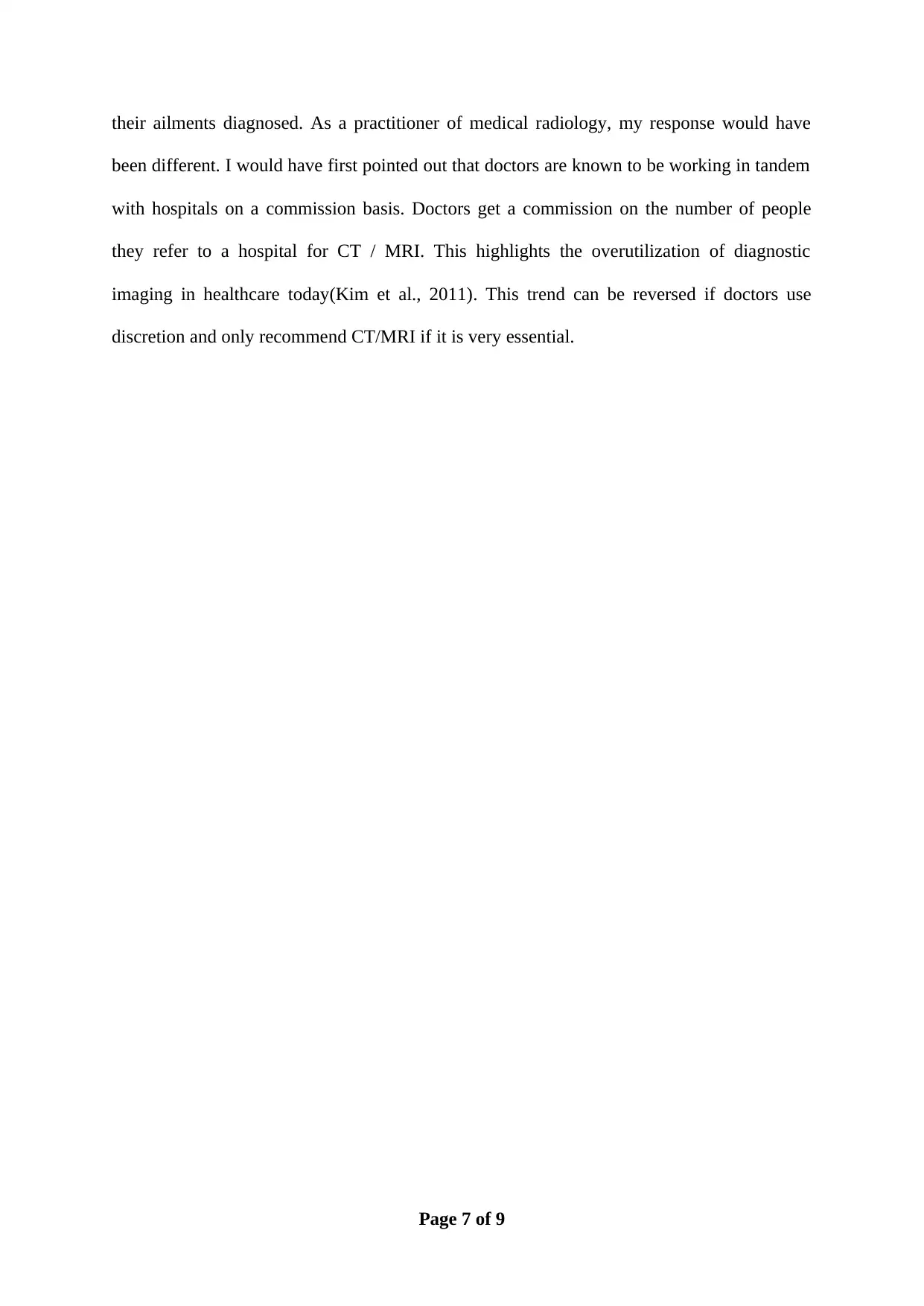
their ailments diagnosed. As a practitioner of medical radiology, my response would have
been different. I would have first pointed out that doctors are known to be working in tandem
with hospitals on a commission basis. Doctors get a commission on the number of people
they refer to a hospital for CT / MRI. This highlights the overutilization of diagnostic
imaging in healthcare today(Kim et al., 2011). This trend can be reversed if doctors use
discretion and only recommend CT/MRI if it is very essential.
Page 7 of 9
been different. I would have first pointed out that doctors are known to be working in tandem
with hospitals on a commission basis. Doctors get a commission on the number of people
they refer to a hospital for CT / MRI. This highlights the overutilization of diagnostic
imaging in healthcare today(Kim et al., 2011). This trend can be reversed if doctors use
discretion and only recommend CT/MRI if it is very essential.
Page 7 of 9
Paraphrase This Document
Need a fresh take? Get an instant paraphrase of this document with our AI Paraphraser
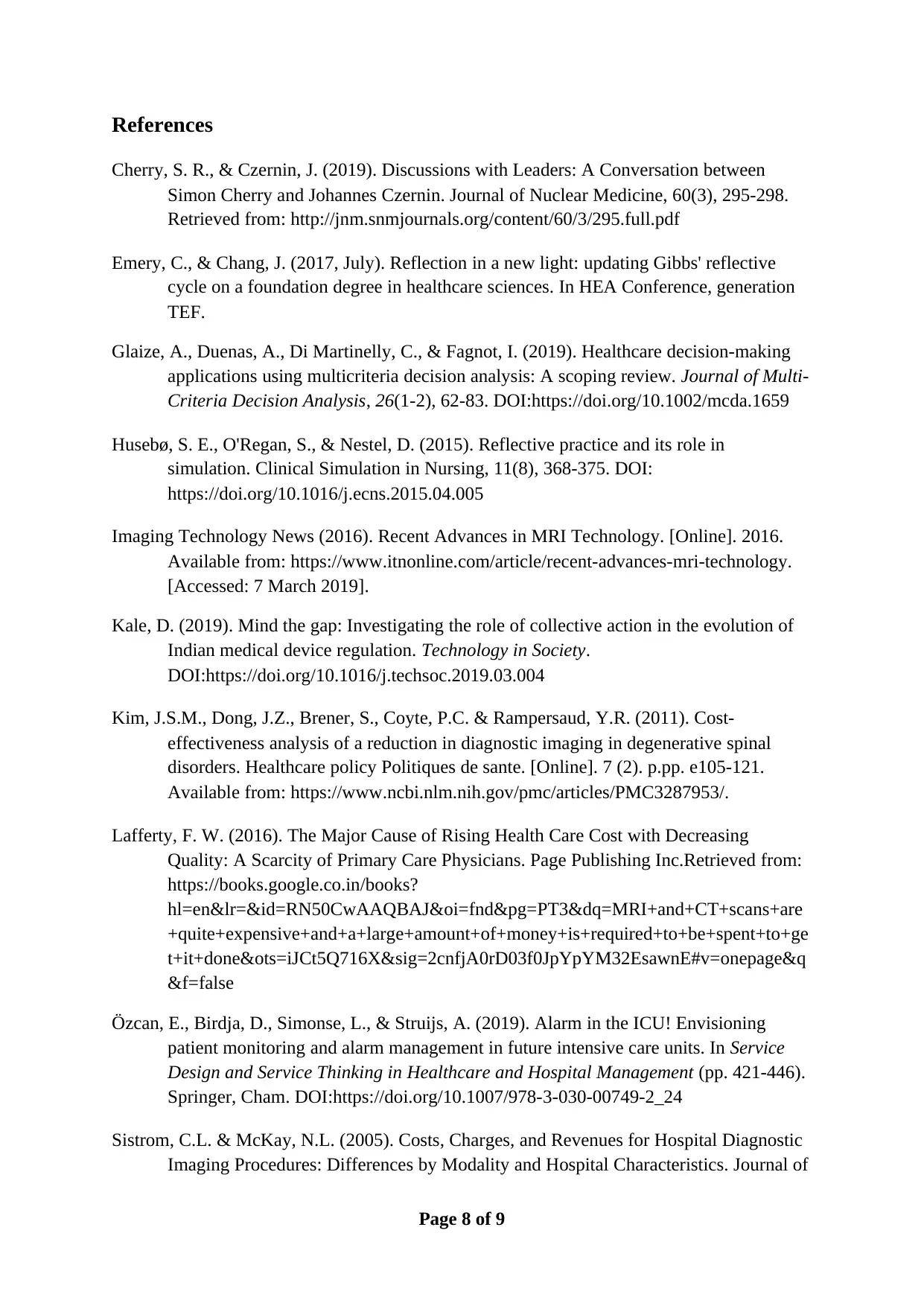
References
Cherry, S. R., & Czernin, J. (2019). Discussions with Leaders: A Conversation between
Simon Cherry and Johannes Czernin. Journal of Nuclear Medicine, 60(3), 295-298.
Retrieved from: http://jnm.snmjournals.org/content/60/3/295.full.pdf
Emery, C., & Chang, J. (2017, July). Reflection in a new light: updating Gibbs' reflective
cycle on a foundation degree in healthcare sciences. In HEA Conference, generation
TEF.
Glaize, A., Duenas, A., Di Martinelly, C., & Fagnot, I. (2019). Healthcare decision‐making
applications using multicriteria decision analysis: A scoping review. Journal of Multi‐
Criteria Decision Analysis, 26(1-2), 62-83. DOI:https://doi.org/10.1002/mcda.1659
Husebø, S. E., O'Regan, S., & Nestel, D. (2015). Reflective practice and its role in
simulation. Clinical Simulation in Nursing, 11(8), 368-375. DOI:
https://doi.org/10.1016/j.ecns.2015.04.005
Imaging Technology News (2016). Recent Advances in MRI Technology. [Online]. 2016.
Available from: https://www.itnonline.com/article/recent-advances-mri-technology.
[Accessed: 7 March 2019].
Kale, D. (2019). Mind the gap: Investigating the role of collective action in the evolution of
Indian medical device regulation. Technology in Society.
DOI:https://doi.org/10.1016/j.techsoc.2019.03.004
Kim, J.S.M., Dong, J.Z., Brener, S., Coyte, P.C. & Rampersaud, Y.R. (2011). Cost-
effectiveness analysis of a reduction in diagnostic imaging in degenerative spinal
disorders. Healthcare policy Politiques de sante. [Online]. 7 (2). p.pp. e105-121.
Available from: https://www.ncbi.nlm.nih.gov/pmc/articles/PMC3287953/.
Lafferty, F. W. (2016). The Major Cause of Rising Health Care Cost with Decreasing
Quality: A Scarcity of Primary Care Physicians. Page Publishing Inc.Retrieved from:
https://books.google.co.in/books?
hl=en&lr=&id=RN50CwAAQBAJ&oi=fnd&pg=PT3&dq=MRI+and+CT+scans+are
+quite+expensive+and+a+large+amount+of+money+is+required+to+be+spent+to+ge
t+it+done&ots=iJCt5Q716X&sig=2cnfjA0rD03f0JpYpYM32EsawnE#v=onepage&q
&f=false
Özcan, E., Birdja, D., Simonse, L., & Struijs, A. (2019). Alarm in the ICU! Envisioning
patient monitoring and alarm management in future intensive care units. In Service
Design and Service Thinking in Healthcare and Hospital Management (pp. 421-446).
Springer, Cham. DOI:https://doi.org/10.1007/978-3-030-00749-2_24
Sistrom, C.L. & McKay, N.L. (2005). Costs, Charges, and Revenues for Hospital Diagnostic
Imaging Procedures: Differences by Modality and Hospital Characteristics. Journal of
Page 8 of 9
Cherry, S. R., & Czernin, J. (2019). Discussions with Leaders: A Conversation between
Simon Cherry and Johannes Czernin. Journal of Nuclear Medicine, 60(3), 295-298.
Retrieved from: http://jnm.snmjournals.org/content/60/3/295.full.pdf
Emery, C., & Chang, J. (2017, July). Reflection in a new light: updating Gibbs' reflective
cycle on a foundation degree in healthcare sciences. In HEA Conference, generation
TEF.
Glaize, A., Duenas, A., Di Martinelly, C., & Fagnot, I. (2019). Healthcare decision‐making
applications using multicriteria decision analysis: A scoping review. Journal of Multi‐
Criteria Decision Analysis, 26(1-2), 62-83. DOI:https://doi.org/10.1002/mcda.1659
Husebø, S. E., O'Regan, S., & Nestel, D. (2015). Reflective practice and its role in
simulation. Clinical Simulation in Nursing, 11(8), 368-375. DOI:
https://doi.org/10.1016/j.ecns.2015.04.005
Imaging Technology News (2016). Recent Advances in MRI Technology. [Online]. 2016.
Available from: https://www.itnonline.com/article/recent-advances-mri-technology.
[Accessed: 7 March 2019].
Kale, D. (2019). Mind the gap: Investigating the role of collective action in the evolution of
Indian medical device regulation. Technology in Society.
DOI:https://doi.org/10.1016/j.techsoc.2019.03.004
Kim, J.S.M., Dong, J.Z., Brener, S., Coyte, P.C. & Rampersaud, Y.R. (2011). Cost-
effectiveness analysis of a reduction in diagnostic imaging in degenerative spinal
disorders. Healthcare policy Politiques de sante. [Online]. 7 (2). p.pp. e105-121.
Available from: https://www.ncbi.nlm.nih.gov/pmc/articles/PMC3287953/.
Lafferty, F. W. (2016). The Major Cause of Rising Health Care Cost with Decreasing
Quality: A Scarcity of Primary Care Physicians. Page Publishing Inc.Retrieved from:
https://books.google.co.in/books?
hl=en&lr=&id=RN50CwAAQBAJ&oi=fnd&pg=PT3&dq=MRI+and+CT+scans+are
+quite+expensive+and+a+large+amount+of+money+is+required+to+be+spent+to+ge
t+it+done&ots=iJCt5Q716X&sig=2cnfjA0rD03f0JpYpYM32EsawnE#v=onepage&q
&f=false
Özcan, E., Birdja, D., Simonse, L., & Struijs, A. (2019). Alarm in the ICU! Envisioning
patient monitoring and alarm management in future intensive care units. In Service
Design and Service Thinking in Healthcare and Hospital Management (pp. 421-446).
Springer, Cham. DOI:https://doi.org/10.1007/978-3-030-00749-2_24
Sistrom, C.L. & McKay, N.L. (2005). Costs, Charges, and Revenues for Hospital Diagnostic
Imaging Procedures: Differences by Modality and Hospital Characteristics. Journal of
Page 8 of 9
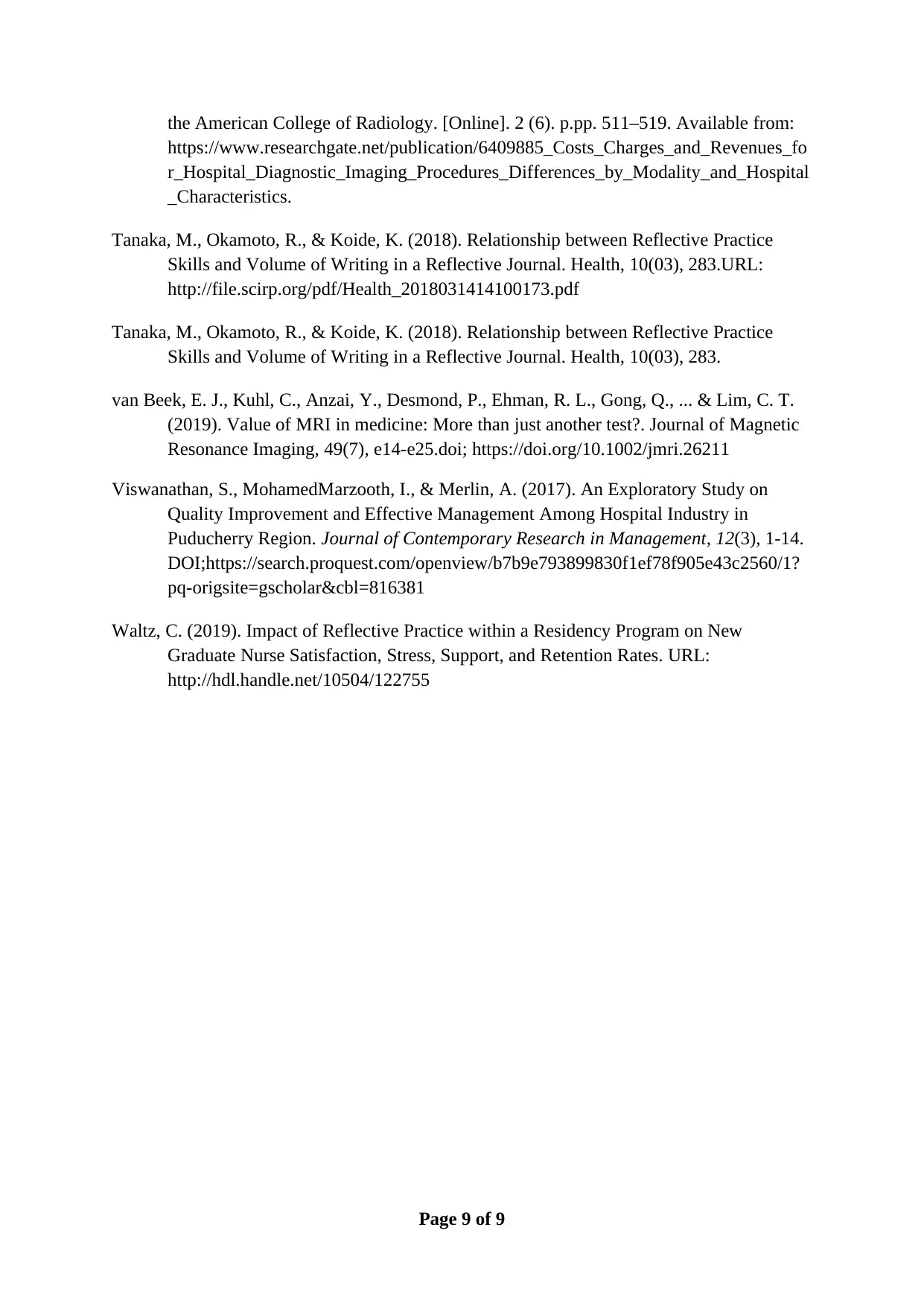
the American College of Radiology. [Online]. 2 (6). p.pp. 511–519. Available from:
https://www.researchgate.net/publication/6409885_Costs_Charges_and_Revenues_fo
r_Hospital_Diagnostic_Imaging_Procedures_Differences_by_Modality_and_Hospital
_Characteristics.
Tanaka, M., Okamoto, R., & Koide, K. (2018). Relationship between Reflective Practice
Skills and Volume of Writing in a Reflective Journal. Health, 10(03), 283.URL:
http://file.scirp.org/pdf/Health_2018031414100173.pdf
Tanaka, M., Okamoto, R., & Koide, K. (2018). Relationship between Reflective Practice
Skills and Volume of Writing in a Reflective Journal. Health, 10(03), 283.
van Beek, E. J., Kuhl, C., Anzai, Y., Desmond, P., Ehman, R. L., Gong, Q., ... & Lim, C. T.
(2019). Value of MRI in medicine: More than just another test?. Journal of Magnetic
Resonance Imaging, 49(7), e14-e25.doi; https://doi.org/10.1002/jmri.26211
Viswanathan, S., MohamedMarzooth, I., & Merlin, A. (2017). An Exploratory Study on
Quality Improvement and Effective Management Among Hospital Industry in
Puducherry Region. Journal of Contemporary Research in Management, 12(3), 1-14.
DOI;https://search.proquest.com/openview/b7b9e793899830f1ef78f905e43c2560/1?
pq-origsite=gscholar&cbl=816381
Waltz, C. (2019). Impact of Reflective Practice within a Residency Program on New
Graduate Nurse Satisfaction, Stress, Support, and Retention Rates. URL:
http://hdl.handle.net/10504/122755
Page 9 of 9
https://www.researchgate.net/publication/6409885_Costs_Charges_and_Revenues_fo
r_Hospital_Diagnostic_Imaging_Procedures_Differences_by_Modality_and_Hospital
_Characteristics.
Tanaka, M., Okamoto, R., & Koide, K. (2018). Relationship between Reflective Practice
Skills and Volume of Writing in a Reflective Journal. Health, 10(03), 283.URL:
http://file.scirp.org/pdf/Health_2018031414100173.pdf
Tanaka, M., Okamoto, R., & Koide, K. (2018). Relationship between Reflective Practice
Skills and Volume of Writing in a Reflective Journal. Health, 10(03), 283.
van Beek, E. J., Kuhl, C., Anzai, Y., Desmond, P., Ehman, R. L., Gong, Q., ... & Lim, C. T.
(2019). Value of MRI in medicine: More than just another test?. Journal of Magnetic
Resonance Imaging, 49(7), e14-e25.doi; https://doi.org/10.1002/jmri.26211
Viswanathan, S., MohamedMarzooth, I., & Merlin, A. (2017). An Exploratory Study on
Quality Improvement and Effective Management Among Hospital Industry in
Puducherry Region. Journal of Contemporary Research in Management, 12(3), 1-14.
DOI;https://search.proquest.com/openview/b7b9e793899830f1ef78f905e43c2560/1?
pq-origsite=gscholar&cbl=816381
Waltz, C. (2019). Impact of Reflective Practice within a Residency Program on New
Graduate Nurse Satisfaction, Stress, Support, and Retention Rates. URL:
http://hdl.handle.net/10504/122755
Page 9 of 9
1 out of 9
Your All-in-One AI-Powered Toolkit for Academic Success.
+13062052269
info@desklib.com
Available 24*7 on WhatsApp / Email
![[object Object]](/_next/static/media/star-bottom.7253800d.svg)
Unlock your academic potential
© 2024 | Zucol Services PVT LTD | All rights reserved.



